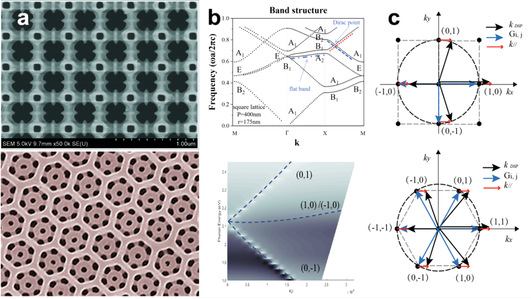

▶Academic reports
▶陈赓 Talent Class Forum
▶Teachering activities
▶Lighting the Blue(LtB) Forum / International Day of Light (IDL)celebrating
Even though photonic devices and technologies have profound influence on human's society, its capabilities have not been fully exploited. In the broadest sense, nano-scale patterning are the critical promoters that will allow mankind to take full advantage of photonic systems. In order to further utilize the nanopatterns, we must gain better understanding of the light-matter interactions that occur in nano-scale, and develop advanced techniques to construct artificial photonic lattice in large scale for practical applications. The Photonic Materials Group (PMG) takes responsible to efficiently construct complex nanopatterns beyond centimeter scale. The ultra-fast laser source, angle-resolved spectrometry, and numerical simulation are deployed to shed light on their physical properties. The specific researches in PMG include:
Because of the periodicity and symmetry of the lattice, the macroscopic optical properties of photonic crystals can be modulated by lattice arrangement, which correlate with their characteristics in the reciprocal space. For instance, embed photonic atoms at high symmetry points (a) can modify the first Brillion zone by lifting or suppressing the Dirac point (or Dirac-like point) in hexagonal/honeycomb lattice (or square lattice), or generating flat band structure (b). The modern diffraction theory (c) and group theory are useful tools to investigate the evolution of degenerate states and their symmetrical properties.

Fig. 1 Figure 2 (a) Superlattice with different embedded structures at high symmetry points; (b) Experimental and theoretical dispersions and band structures; (c) Energy-momentum diagram of the diffracted photons.
The flexible modulation of Surface Plasmons (SPs) on micro-/nanostructures is an interdisciplinary frontier of materials science and nanophotonics. With the assistance of hierarchically structural alumina membrane (a), it is possible to actively tune SPs based on reversible/ gradual micro-deformation of 2D superlattices using external (optical, electric, thermal) fields (b), which is of great importance for promoting the applications of active response optical devices (c).

Figure 3 (a) Hierarchical alumina membranes; (b) Actively reversible hierarchical photonic crystals; (c) Simulated E-field distributions before and after external stimulation.